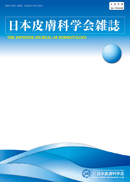All issues

Volume 112, Issue 10
Displaying 1-7 of 7 articles from this issue
- |<
- <
- 1
- >
- >|
CME Lecture
-
[in Japanese]Article type: CME Lecture
2002Volume 112Issue 10 Pages 1343-1356
Published: September 20, 2002
Released on J-STAGE: December 27, 2014
JOURNAL RESTRICTED ACCESSDownload PDF (290K)
Original Articles
-
Yoko Nishiwaki, Yoshiteru Yamamoto, Sachiko MiyagawaArticle type: Original Articles
2002Volume 112Issue 10 Pages 1357-1362
Published: September 20, 2002
Released on J-STAGE: December 27, 2014
JOURNAL RESTRICTED ACCESSWe saw 24 patients with sarcoidosis skin lesions in our department from 1982 to 2001. These cases included 4males and 20 females ; their average age was 51 years. The types of skin lesions include 6 cases of plaques, 4 cases of subcutaneous nodules, 4 cases of nodules, 4 cases of lichenoid form, 2 cases of scar sarcoidosis, and 1 case of infiltrative form. Three cases had two types of skin lesions. In our cases, there was no correlation between the extent of skin lesions and serum ACE level.View full abstractDownload PDF (479K) -
Yoshinori Umezawa, Tsunao Oh-i, Noriko Ioya, Masaharu YoshidaArticle type: Original Articles
2002Volume 112Issue 10 Pages 1363-1366
Published: September 20, 2002
Released on J-STAGE: December 27, 2014
JOURNAL RESTRICTED ACCESSNephropathy is one of the clinically important adverse reactions associated with psoriasis therapy utilizing cyclosporin (CYA). In the present study, kidney biopsies were performed on nine patients with psoriasis and one patient with pyoderma gangrenosum who underwent CYA therapy. Biopsy specimens were analyzed histologically to investigate the relationships between biopsy findings and factors such as CYA dosage. The nine patients with psoriasis (eight men and two women renged in ages from 32 to 72 years), and the one patient with pyoderma gangrenosum was a 32 year-old woman. The duration of CYA therapy ranged from 6 weeks to 11 years (mean : 3.15 years). Glomerular, interstitial and vascular changes were assessed, quantified, and expressed as CYA nephropathy scores. The relationships between CYA nephropathy scores and the following factors were analyzed : age, duration of CYA therapy, mean CYA dosage, total CYA dosage, serum creatinine at the time of the biopsy, and 24-hour creatinine clearance (24hCcr). There was no statistically significant correlation between CYA nephropathy scores and any of the above factors, However a correlation was observed between CYA nephropathy scores and two factors, age and 24hCcr. These findigns demonstrate the need for caution when administering CYA to the elderly and further suggest that 24hCcr can be useful is ascertaining the severity of CYA-induced nephropathy.View full abstractDownload PDF (45K) -
Yoshinori Umezawa, Mika Konno, Tomotakai Mabuchi, Mariko Iizuka, Takas ...Article type: Original Articles
2002Volume 112Issue 10 Pages 1367-1370
Published: September 20, 2002
Released on J-STAGE: December 27, 2014
JOURNAL RESTRICTED ACCESSThe clinical efficacy of cyclosporine (CYA) therapy for psoriasis has been established. However, side effects associated with toxicity of CYA have been also discussed. It may be important to determine CYA dosage based on the TDM for psoriasis, in order to have more therapeutic success without adverse events. In this study, we investigated the possibility of using the TDM as a therapeutic marker for psoriasis treatment with CYA-MEPC (Neoral). Twenty-two patients with psoriasis vulgaris were given 3.0mg/kg/day Neoral twice per day. We measured 4 points (C0 (base levels), C1 (1hr post dose), C2 (2hr post dose), andC4 (4hr post dose)) of pharmacokinetics during the 4 hours following administration of the drug and calculated AUC0-4 (area under concentration-time curve 0-4 hr). The relationships between AUC0-4 and C0, C1, C2, C4 were analyzed. There was a correlation between C2 and AUC0-4 (r=0.87, p<0.001). AUC0-4 correlations with clinical events during cyclosporine treatment were recognized in transplant recipient patients. These results suggest that C2 monitoring is important for determining CYA dosage based on the TDM for psoriasis.View full abstractDownload PDF (51K) -
Byung-Kwi Chung, Yozo Murata, Kimiko Kumano, Toshihiro Takai, Keiji Mi ...Article type: Original Articles
2002Volume 112Issue 10 Pages 1371-1376
Published: September 20, 2002
Released on J-STAGE: December 27, 2014
JOURNAL RESTRICTED ACCESSBone metastases diffusely invading the bone marrow infrequently manifest a rapid course. The prognosis is very poor and is complicated by hematologic disorders such as DIC (disseminated intravascularcoagulation) and MAHA (microangiopathic hemolytic anemia). This condition is often caused by metastases from adenocarcinomas of the stomach and is called disseminated carcinomatosis of the bone marrow. We report a rare case of malignant melanoma complicated by disseminated carcinomatosis of the bone marrow. A 50-year-old Japanese female had an acral lentigenous melanoma on her right sole and a palpable regional lymph node. One month after an operation, she developed rapidly progressing anemia, DIC, and leukoerythroblastosis. A bone marrow biopsy showed diffuse replacemant of the marrow by melanoma cells and involvement of the intraluminal spaces of bone marrow sinusoids. Despite chemotherapy with DTIC, supportive therapy with gabexate mesilate, and transfusions of erythrocytes and platelets, she died five months after first visit.View full abstractDownload PDF (584K) -
Junko IkurumiArticle type: Original Articles
2002Volume 112Issue 10 Pages 1377-1380
Published: September 20, 2002
Released on J-STAGE: December 27, 2014
JOURNAL RESTRICTED ACCESSA 23-old female patient with pemphigus vulgaris took steroids orally at a dose of 1 to 1.5mg/kg. However, her exanthema did not improve, and no decrease in anti-desmoglein (Dsg) antibody titer was observed. Double filtration plasmapheresis (DFPP) was performed 18 times over 2 months. The patient’s blisters improved and her anti-Dsg antibody titer began to decrease at the 10th DFPP treatment. Considering the low antibody titer and improved exanthema, we terminated DFPP therapy at the 18th session and reduced her steroid dose. We belive that the anti-Dsg antibody titer is useful in determining the frequency and termination time of DFPP.View full abstractDownload PDF (234K)
Abstracts
-
2002Volume 112Issue 10 Pages 1381-1403
Published: 2002
Released on J-STAGE: December 27, 2014
JOURNAL RESTRICTED ACCESSDownload PDF (4000K)
- |<
- <
- 1
- >
- >|